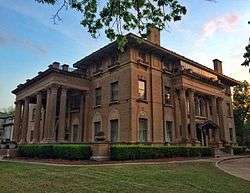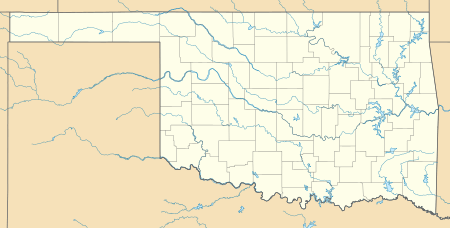Hales Mansion
The Hales Mansion is a mansion built in 1916 in Oklahoma City's Heritage Hills neighborhood.
W. T. Hales House | |
 | |
  | |
| Location | 1521 N. Hudson Ave., Oklahoma City, Oklahoma |
|---|---|
| Coordinates | 35°29′9″N 97°31′9″W |
| Area | 1.17 acres |
| Built | 1916 |
| Architect | Hawk & Parr |
| Architectural style | Renaissance, Italian Renaissance Revival |
| NRHP reference No. | 78002245[1] |
| Added to NRHP | March 29, 1978 |
History
The Second Renaissance Revival house[2] was built for William Taylor Hales (1867-1938),[3] a prominent business man of early Oklahoma City, in 1916 at a cost of $125,000 USD. In 1939, the mansion was bought by the Roman Catholic Archdiocese of Oklahoma City and served as the residence of the archbishop until it was converted back into a private residence in 1992. The mansion was added to the National Register of Historic Places in 1978.[4] In April 2017, the mansion was bought by an Oklahoma City radiologist for $2.125 million.
Architecture
The house contains 20,021 square feet of living space spread over three floors, and an additional 3,136 square feet of basement,[5] making the Hales Mansion the largest residence in Oklahoma City. The mansion was designed by the firm Hawk & Parr and is constructed of Bedford limestone and bricks imported from Greece. The main entrance on the east facade is a large, two-story portico supported by eight Corinthian columns. The secondary entrance on the north facade, facing the Overholser Mansion, is also a two-story portico but supported by four columns. On the ground level, the main entrance opens into a grand hall and a grand staircase.
References
- "National Register Information System". National Register of Historic Places. National Park Service. July 9, 2010.
- http://nr_shpo.okstate.edu/nhrpdfs/79002006.pdf
- "William Taylor "W T" Hales (1867-1938) - Find A..." www.findagrave.com.
- http://nr_shpo.okstate.edu/shpopic.asp?id=78002245
- http://www.oklahomacounty.org/assessor/Searches/Sketches/sketchfile/2710/R043565500001.jpg